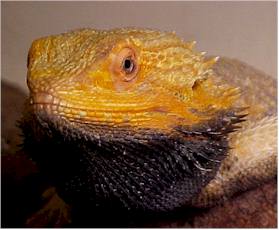
Bearded Dragon Care & Breeding
(Pogona vitticeps)

The "Inland Bearded Dragon" rightfully earns it's name by the very pronounced beard sometimes shown in defensive displays as well as during mating behavior. By puffing out their throat area, both males and females can display a beard, although the male's is usually a much darker almost pitch black beard. Adult bearded dragons average 15 to 24 inches in length, while hatchlings are between 3 to 4 inches at birth. Young dragons grow fast and are sexually mature by one year of age. Juvenile beardeds usually start showing their coloration by two months of age.
Housing
Bearded dragons can be housed in a variety of enclosures as long as their basic requirements are met. All glass aquaria with wire tops are commonly used and are inexpensive to obtain. Custom built enclosures are also very popular and can be sized appropriately. The enclosure should have a basking spot with temperatures ranging from 90 to 105 degrees Fahrenheit, which can be provided by an overhead light in a reflective hood. Under tank heating can be used for night time use, supplied by a heating pad or tape. The enclosure should be large enough to allow the lizard to retreat to a cooler area (known as thermoregulation) as needed. A tree branch or log should be supplied for climbing and basking. Good substrates are newspaper, sand, pea rock or aquarium gravel. Substrates such as mulch, shredded tree bark, or corn cob should not be used as they can hold moisture and promote bacterial growth.
Feeding

Vitamin/mineral supplementation can be offered by "dusting" the food items a couple times per week.
Bearded dragons should be offered a varied diet consisting of crickets, mealworms, pink or fuzzy mice and a variety of greens and vegetables. Juvenile animals can be raised on small crickets and greens until large enough to eat mealworms and mice. It is very important to regulate the size cricket given to juvenile dragons. Large meals have been associated with partial paralysis and hind leg extension. A general rule is to use crickets no larger than the distance between the dragons eyes to the tip of his nose, and should be offered in several small meals per day rather than one large one. Crickets should be dusted with a vitamin/mineral supplement every other day for up to three months, then reducing supplementation to twice a week. Fresh greens, such as collards, kale, and mustard greens should be finely chopped and offered every other day along with vegetables such as yellow squash, zucchini and shredded carrots. Be sure to thoroughly wash all greens and vegetables before offering them to your dragon.
Bearded dragons in the wild get their water from the morning dew on plants and afternoon rains. In captivity, they seem to have a difficult time recognizing standing water. A simple means of offering water is to spray them at least once or twice a day with a spray mist bottle. They will lap up the water off of their noses and lower their head to standing puddles if some type of movement is detected.
Lighting
Bearded dragons (if kept indoors) will require full spectrum lighting with UV-B and UV-A, which helps in synthesizing vitamin D-3 which is required for calcium absorption. These bulbs can be purchased from Zoo-med (Reptisun 5.0) and are relatively inexpensive. Vitamin/mineral supplements which contain vitamin D-3 should be used to dust crickets and/or greens to ensure proper calcium absorption for bone development in growing dragons. Bearded dragons which are kept outdoors or are allowed at least 30 minutes of natural sunlight every other day will not require any special lighting as long as a basking spot with an incandescent bulb is supplied.
Handling
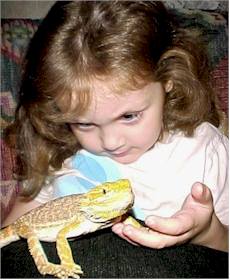
Their gentle disposition makes them an excellent reptilian pet, even for young enthusiasts.
Newly acquired bearded dragons should be allowed to get acclimated to their new enclosures and feeding schedules before attempting to handle them. Once acclimated, short periods of handling and hand feeding will quickly tame most dragons. They will be content to sit on a shoulder or lap for hours while watching TV or using the computer. Young children should be supervised and instructed on careful handling techniques. Be sure to wash your hands before eating or smoking after handling any reptile.
Sexing:
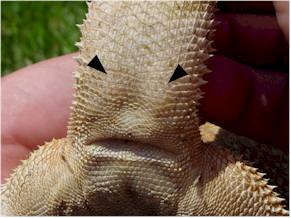
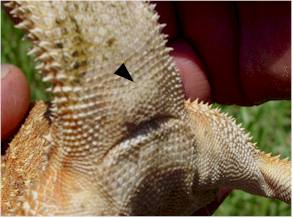
The male (left) clearly shows the hemipenal bulges, which causes an indentation in the center of the tail. Females (right) will have a slight protrusion due to the lack of hemipenes.
Sexing very young bearded dragons in somewhat difficult, but determining sex in juveniles over the age of three months is relatively easy. By holding the dragon in the palm of your hand with its tail facing you, carefully fold the tail up over the back and examine the area just above the ventral opening. In males, hemipenal bulges can be seen on each side of the tail. The hemipenes will also cause and indentation in the center of the tail between the two hemipenes. On females, the hemipenal bulges are absent, thus causing the area above the vent to protrude slightly.
Breeding:
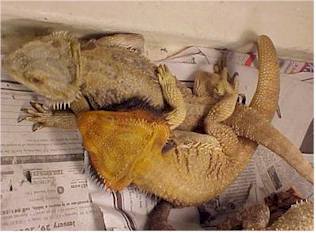
A pair of bearded dragons during copulation.
One of the most prolific agamas, breeding Pogona vitticeps is relatively simple. All that is needed is an adult pair of dragons in good health, a large enough enclosure to allow for breeding activity, and a suitable place for the female to lay her eggs. Successful breeding usually follow a short rest period (known as brumation), where the temperatures and daylight hours are reduced for a period of two to three months. Although most bearded dragons will breed without any type of brumation period, low fertility rates have been reported in both males and females which were not allowed a rest period.
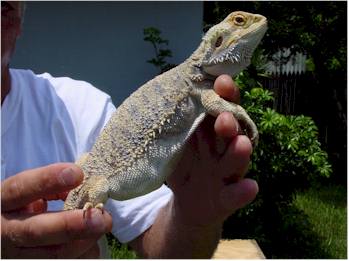
The abdomen of a gravid female clearly showing egg bulges. This female laid 32 eggs four hours after the photo was taken.
Sexually mature males will darken there beards, bob their heads and stamp their front feet during the courtship of the female. He will chase her around the enclosure and attempt to mount the female. Males often bite the fleshy skin at the base of the females neck when attempting to position her for breeding.
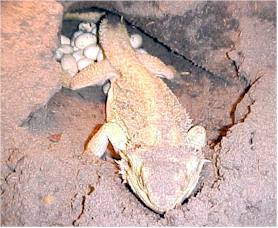
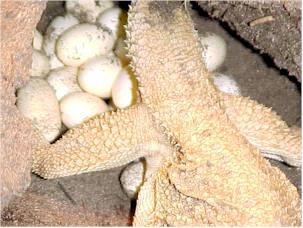
A young female laying a clutch of eggs in a shallow nest. Clutch sizes range from 12 to 30 eggs for most females.
Egg laying generally occurs anywhere from 4 to 6 weeks after a successful breeding. Females will dig a burrow approximately 12" - 16" deep to deposit her eggs. The eggs are carefully excavated and placed in a moist perilite/vermiculite medium for incubation.
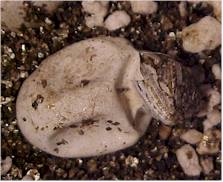
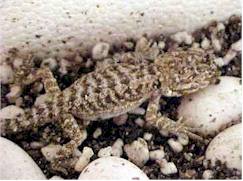
All eggs in a single clutch usually hatch within 24 hours of each other. The hatchlings may remain in the egg after the initial slitting for several hours before emerging.
The eggs are incubated at 82 to 84 degrees Fahrenheit for a period of 65-75 days, at which time the eggs will begin to collapse, and usually hatch within 24 hours. Newly hatched dragons are left in the incubator for a period of 24 hours to allow the yolksac to be absorbed. Young bearded dragons will usually start to feed within 72 hours of hatching.
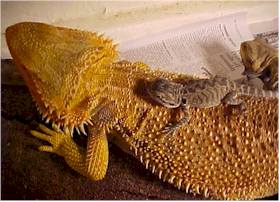
A two week old "Sandfire" dragon placed on its mothers back for size comparison.
Bearded Dragon Morphs
There are several different color and pattern phases of bearded dragons today. Breeders continually selectively breed their animals to produce "enhanced" color and patterns. The "Sandfire" morph is probably the most popular morph available today, along with the Red phase and Red/Gold phase. Albino bearded dragons are not yet available to the public, although we have seen photos of young albino hatchlings. We can not verify the source of the photos, so can not validate that albinos even exist. It will be interesting to see future morphs produced by introducing albinism, if in fact, they do exist.